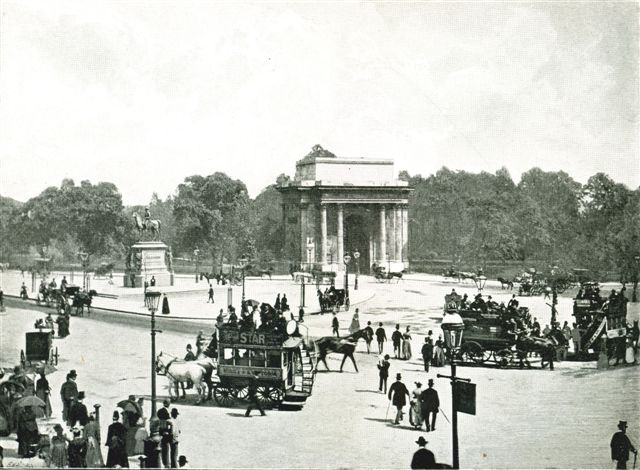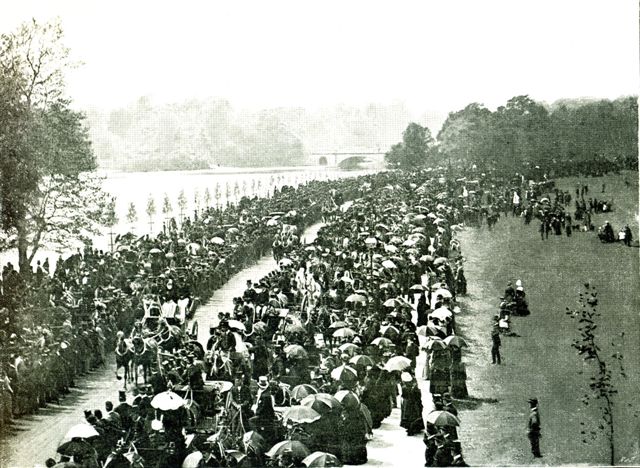|
|
|
 |
VICTORIAN AND EDWARDIAN 'AD' (4) Presented by Ex PC 799 'A'/164477 Leonard Bentley |
 |
|
Ex PC 799 'A' Leonard Bentley continues his escorted tour of Cannon Row's old ground over a century ago with photographs from his personal collection including informative and entertaining comments to accompany them. JH.
|
|
|
Hyde Park Corner looking East Two officers are controlling the two way traffic at a very sedate Hyde Park Corner on a summer’s afternoon; the scene is similar to the one caught on the earliest moving film recorded in England by William Friese -Green a few years earlier in 1889.The corner had been the site of the western tollgate entrance to London, it was removed in 1825 when the Ionic screen designed by Decimus Burton was erected as the entrance to Hyde Park .The Constitution Arch, also by Burton was built opposite the screen in 1828 as the entrance to Constitution Hill which led to the new Buckingham Palace then being built for George IV; at this time Hyde Park Corner was not a roundabout and Constitution Hill ran across what is now Hyde Park Corner to the north west corner. The original design called for a Quadriga, a triumphal chariot drawn by four horses, on the top of the arch but instead a gigantic equestrian statue of The Duke of Wellington was placed there in 1846. The statue was always out of place on the arch and in 1883 the statue was removed to Aldershot and the arch dismantled and moved southeast to the top of a truncated Constitution Hill as can be seen in the first photograph, it was at this time that the corner became a two way roundabout. The arch received its Quadriga in 1912 and in 1960 the arch became marooned in a sea of traffic after Hyde Park Corner was enlarged and ate up chunks of Green Park and the garden of Buckingham Palace. Whilst posted to the arch in the seventies the resident PC showed me a wartime occurrence book and pointed to one entry which described a woman attending the arch to complain about a man she had seen on a bus in Piccadilly who looked suspiciously like a spy. The man had been arrested but let go after convincing his captor that he was not a spy. It was not recorded whether the woman was convinced. The PC also showed me the ‘section house’ accommodation at the top of the arch which while being central must have been very basic. |
 |
| No 1, London, Apsley House RIGHT: This photograph shows the screen and Apsley House the famous home of The Duke of Wellington. The Duke was given the house by a grateful nation in 1817 after it had been bought from Lord Apsley who had built it of brick in 1778; the Duke refaced the house with stone in 1829 and installed the Corinthian portico. The houses on the extreme right next to Apsley House were demolished in 1960 to make way for the Park Lane junction with the corner. The pedestrians are carefully avoiding the mound of horse manure piled up against the traffic island whilst the ‘boardmen’ may be advertising shoe polish. |
 |
|
Four In Hand Club/Coaching Club, Hyde Park A meet of the Four-in-hand and coaching clubs in Hyde Park. The photograph shows a meet of either The Four-in-hand Club or The Coaching club; the clubs met twice a year once before Ascot week and the other before Goodwood. The members of the clubs were invariably members of the aristocracy who could afford to keep expensive carriages and teams of horses, a modern day equivalent would be the carriage driving events although the coaching clubs kept to the road and avoided obstacles. They were judged on their turnout, both horse and human. Each meet usually consisted of thirty to forty carriages mostly Landaus and broughams which were marshalled by Hyde Park Police in front of The Magazine near The Serpentine bridge. They then drove along the north side of the Serpentine which was known as ’The Ladies Mile’ to the South Carriage Road and then left the park at Queens Gate en route for Hurlingham or Ranelagh. I have recently discovered the memoirs of Sergeant Edward Owen who served at Hyde Park from 1874 until his retirement in the mid 1890s; he describes the meet as one of the greatest attractions of the London season and was very proud that the whole thing was dealt with by officers from Hyde Park without any aid from other divisions. His specific job was to keep traffic flowing over the bridge during the meet; he complains about cabbies wanting to stop on the approach to the bridge claiming that they were waiting for their arranged fares, nothing new there then. You can just see the bridge over the serpentine, it was built in 1826 by George Rennie, it used to command a wonderful view of St. James’s Park and Whitehall until the erection of that monstrosity The London eye. |
 |
|
Right:St James's Park Looking West towards Buckingham Palace St. James’s Park and Buckingham Palace. Does anyone know when boating was last permitted on St. James’s Park lake? I have memories of the park since I was a toddler in the fifties, I can even remember the old suspension duck bridge which was replaced in 1957, but I cannot remember boating on the lake. My parents’ idea of a day out on a Sunday was to catch a number 53 bus from the Old Kent Road to Parliament Street and then walk around with the kids in tow. My overwhelming memory of the park was the large number of couples who were engaged in extreme snogging on the grass, they were everywhere. Another memory is of an elderly lady who had a small pet monkey on a lead, she told us kids that she took the monkey for a walk everyday in the park; it makes a change from walking the dog. This photograph about 1894, makes Buckingham Palace look very careworn and down at heel, in fact it was. The Palace had been built by Nash for George IV and had been faced with Caen stone which was badly affected by the smoke and pollution of London. The Palace was refaced in Portland stone in 1913/14. Whilst doing the Guard change in the seventies an elderly gent approached me and started talking about an occasion he attended as a small boy outside the Palace. He described seeing George V, Queen Mary and Kaiser Wilhelm II with a guard of honour comprising Prussian Guards. He told me that he knew they were Prussian because they Goose- Stepped around the place. He was describing the dedication of The Victoria monument on 16th May 1911. The monument designed by Sir Thomas Brock was part of Sir Aston Webb’s design for a processional route which included Admiralty Arch, The Mall and The Rond Point in front of the Palace. He had begun the work in 1903 and finished it with the renovations to Buckingham Palace just before the outbreak of WWI. |
 |
|
Buckingham Palace This photograph shows a closer view of the Palace although it does not show the sentry boxes which were at this time outside the railings on the pavement. My Grandfather was a Grenadier Guardsman before WWI and often did guard duty outside the railings. I believe that the sentries were withdrawn to the forecourt of the Palace sometime in the 1950s due to harassment by tourists.
|
 |
|
Duke of York Column looking North from The Mall
In this photograph workmen are doing something to the top flight of steps, pedestrians are being funnelled to the left of the column. I cannot imagine that the steps are being renewed because they are made of granite quarried from Herm Island near Guernsey. At the time the photograph was taken the steps had been in place since 1834 a good sixty years, perhaps they were being re-laid. Frederick Augustus, second son of George III, commander in chief of the Army and The Grand old Duke of York in the famous nursery rhyme, stands on top of a Tuscan column made of Aberdeenshire granite 124 feet high. At the time of building in 1831-34 a popular joke was that he stood so high so as to be out of reach of his creditors; when he died in1827 he was 2 million pounds in debt. The whole structure including the 53 square feet of concrete foundations cost 25,000 pounds, most of which was raised by stopping the pay of every officer and soldier in the Army for one day. The column was designed by Sir Benjamin Wyatt and the bronze 14 feet statue was sculpted by Sir Richard Westmacott. The column was opened to the public but almost immediately the paving slabs beneath the column became witnesses to sickening thuds as it became a popular venue for suicides. The railings surrounding the square balcony were raised but the suicides found a way and the column was closed to the public in the 1850s. I heard a story that a PC from AD had climbed the spiral staircase to the top in company with a maintenance crew and reported that the staircase was covered with the droppings from generations of pigeons. The entrance to The Institute of Contemporary Arts has not yet been made and the building on the left in Carlton House Terrace is The German Embassy after having been Prussia House since it was built. |
|
|
TO TAKE THE FINAL STEPS OF YOUR ESCORTED TOUR CLICK ON THE DUKE OF YORK COLUMN IMAGE for Victorian and Edwardian AD (5) OR Click On Helmet Image for 'SIGNPOST' (Express Navigation) OR To re trace your steps select ' Victorian and Edwardian AD' (3) (2) or (1) from menu at top of page.
|
|